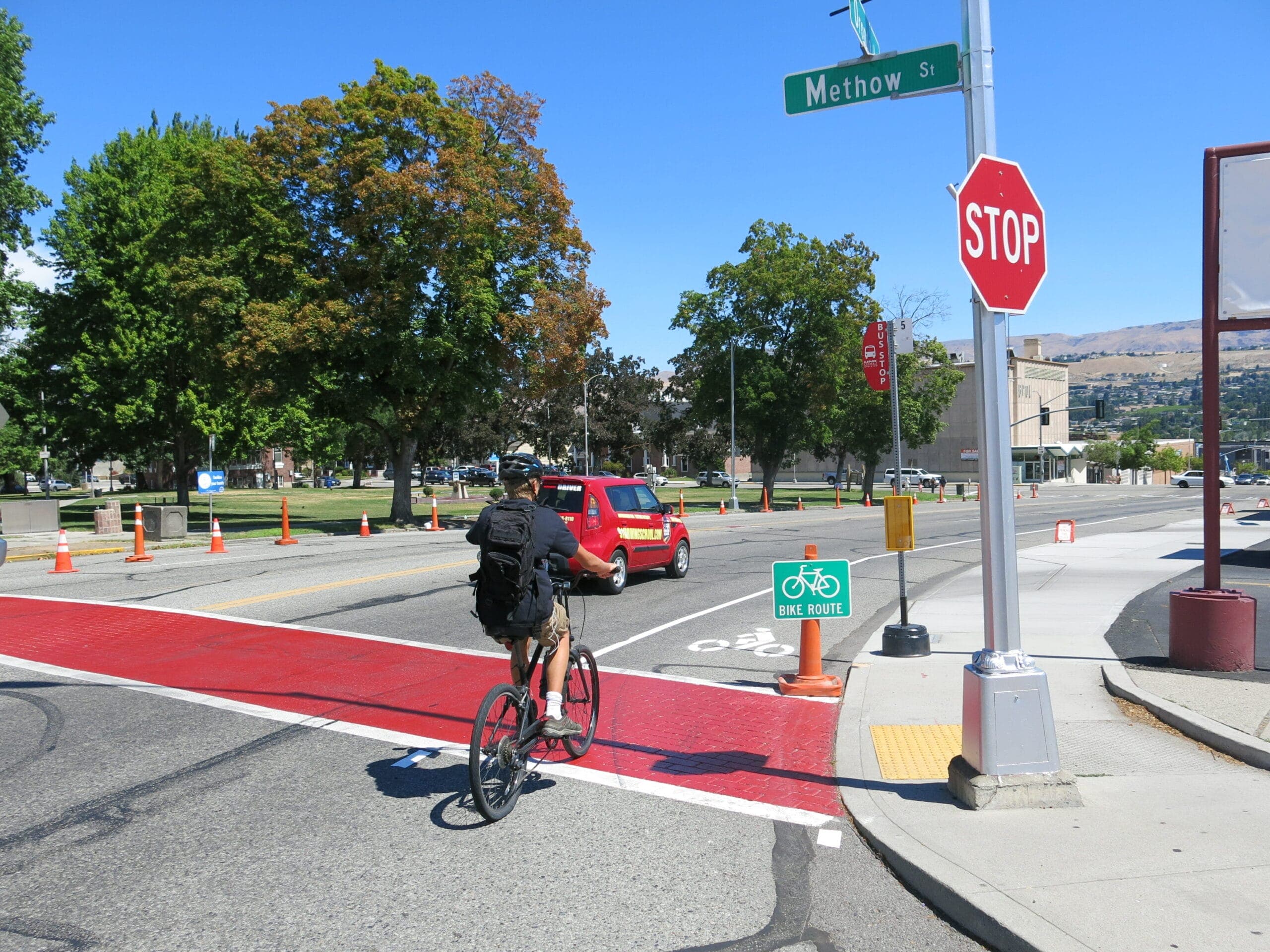
News
By Guest Contributor, May 1, 2024
This post was written by Ken McLeod, Policy Director at The League of American Bicyclists.

Complete Streets offer an opportunity to create safer roads over time, and if we don’t consider pursuing safer speeds through that process, we are missing what makes the Safe System Approach work so well in other countries. Complete Streets improvements such as curb extensions, improved crosswalks, narrower lanes, and protected bike lanes can change road geometry in ways that lower vehicle speeds or increase speed limit compliance. Combining goals for Complete Streets with goals for safer speeds creates complementary benefits for the safety of people biking and walking. For instance, a 2017 report by the Wisconsin DOT recommended “reducing roadway design speeds and narrowing roadway crossing distances to increase the probability of drivers yielding to pedestrians.”
In other countries that have adopted the Safe System Approach, as seen in a recent Federal Highway Administration (FHWA) sponsored review of Australia and New Zealand’s efforts, setting benchmarks related to speed limits and proactively managing speed limits to create more lower-speed roads were identified as key policies. This included setting benchmarks related to the percentage of their urban network with a speed limit of 40 km/h (25 mi/h) or below and the percentage of state highway and local road networks modified to align with a safe and appropriate speed. In contrast, if you look closely at the data shown related to the objective of Safer Speeds by USDOT, you’ll notice that every data point is about the act of speeding and not the speed limits on our roads.
The United States currently lacks data systems to set and report on benchmarks related to safer speeds. According to the FHWA’s Model Inventory of Roadway Elements, speed limits are included in three federal data products: the Highway Performance Monitoring System, the Strategic Highway Research Program 2 Roadway Information Database, and the Highway Safety Manual, but none of these data products produce data on speed limits that align with the benchmark approaches chosen by Australia and New Zealand. Local roads and rural collectors are explicitly excluded from full extent data reporting under the Highway Performance Monitoring System, and speed limits are not required to be reported as part of full extent data. To the extent that speed limits are reported, they are reported for “a random selection of roadway sections” that serves as a sample panel to make estimates for each state, for the purpose of “investment requirements modeling to estimate running speed and for other analysis purposes, including delay estimation” without safety as an explicit purpose.
In its Proven Safety Countermeasures, FHWA says “addressing speed is fundamental to the Safe System Approach to making streets safer.” Complete Streets is a powerful approach because it is an approach that ensures safe access for all users is a priority every time a road or street is repaved, rebuilt, or planned in the first place. Speed limits have a direct impact on what safe access means. A safe bicycle facility for a 20 mph street is not the same as what is a safe facility for a 45 mph road. As speeds go up, the options for safe access for people outside of vehicles go down. Managing speed limits to create more lower-speed roads allows lower-cost, safe facilities and more options for safe road design that can be implemented through the Complete Streets process. Without data systems for speed limits we can’t know the cost and difficulty of making streets complete. Additionally, Complete Streets communicate to drivers what an appropriate is, supporting the speed limit through design and use.
If the United States, or state or local governments within the United States, adopt a benchmark approach for safer speeds, as seen in Australia and New Zealand then every time a street is repaved, rebuilt, or planned is an opportunity to implement a safe and appropriate speed limit. This approach would be in stark contrast to traditional speed limit policy in the United States, where the speed choices of drivers were considered the primary input in determining the speed limit through the use of the “85th percentile” rule. Countless, and currently unaccounted-for, miles of roads received higher speed limits based primarily on the choice of drivers to drive faster while that rule prevailed. Complete Streets provides an opportunity and model for re-establishing and redesigning roads for safer speeds over time based on the principles of the Safe System Approach that prioritize safety over the choices of the fastest 15 percent of drivers.
Slower Roads Save Lives because of physics. Slower speeds create less forceful collisions that are more survivable. To properly implement the Safe System Approach, the United States needs to set benchmarks related to speed limits and collect and report on speed management practices that result in slower, safer speeds. If we do not, we will be missing the secret sauce of the Safe System Approach and trying to reach zero traffic deaths without insight on the basic physics of our transportation system.
Related News

© 2025 Smart Growth America. All rights reserved
Site By3Lane Marketing












